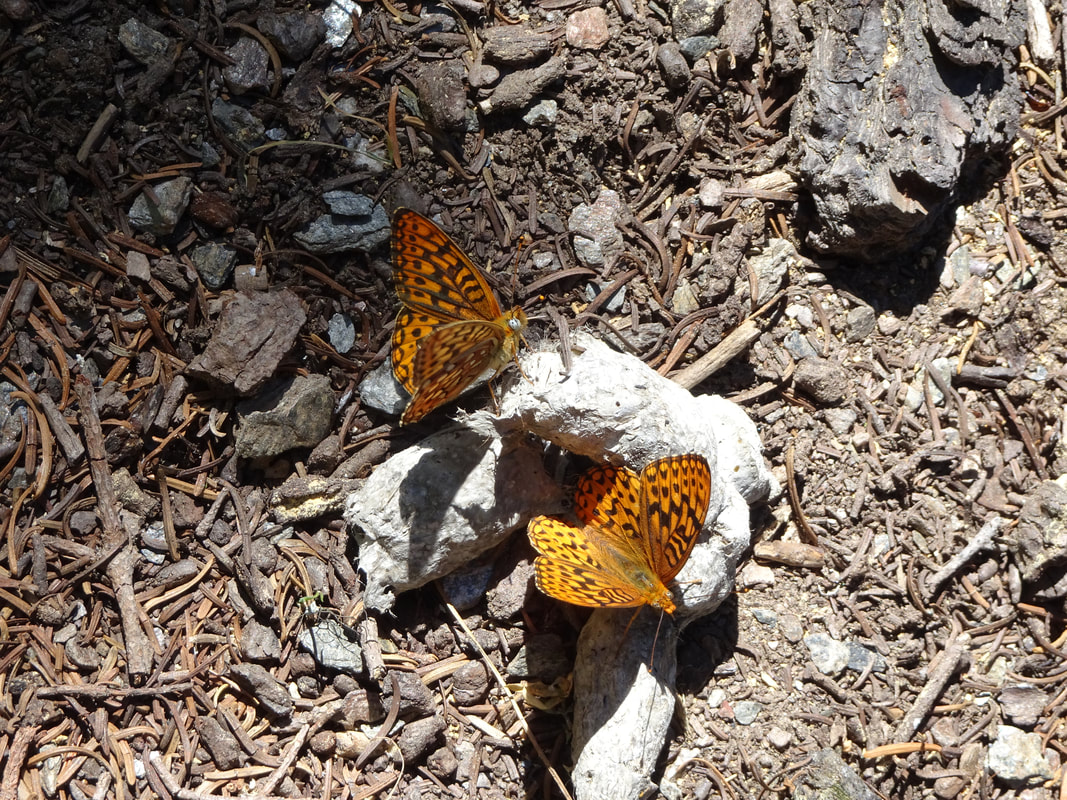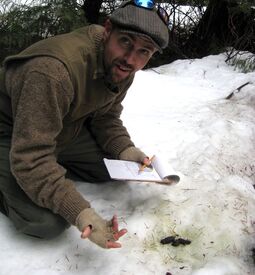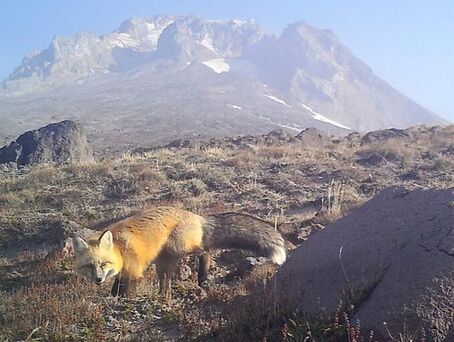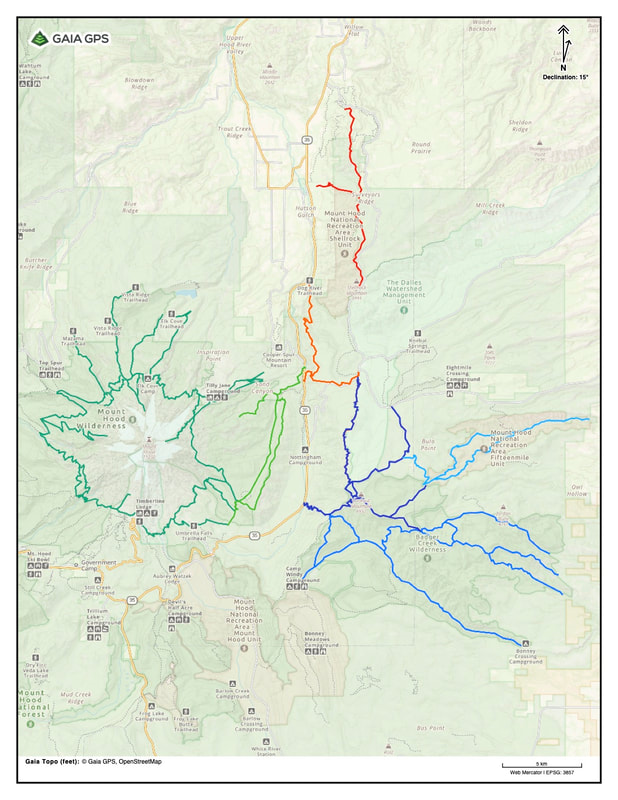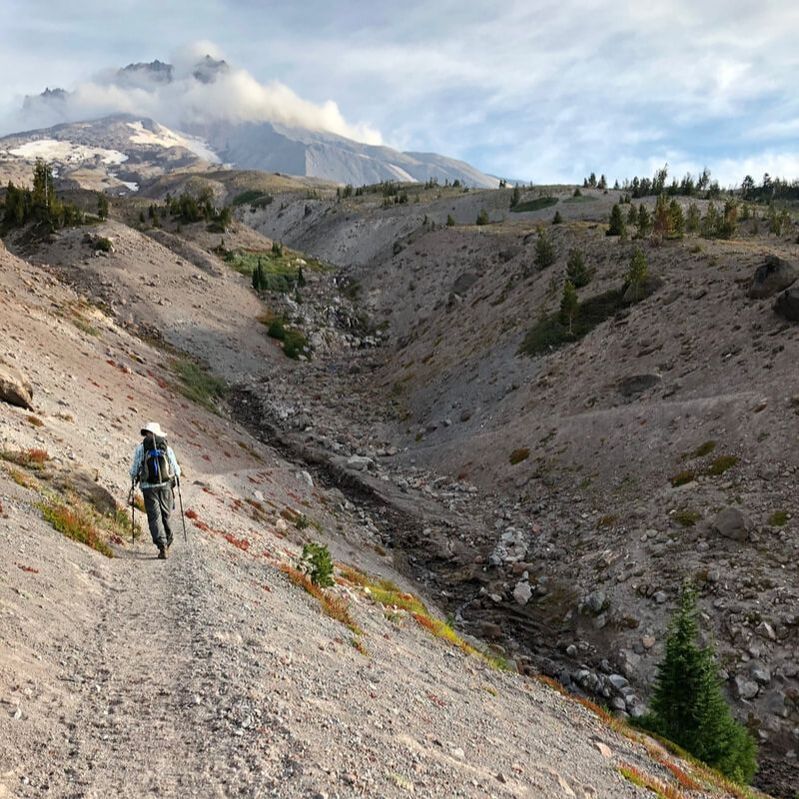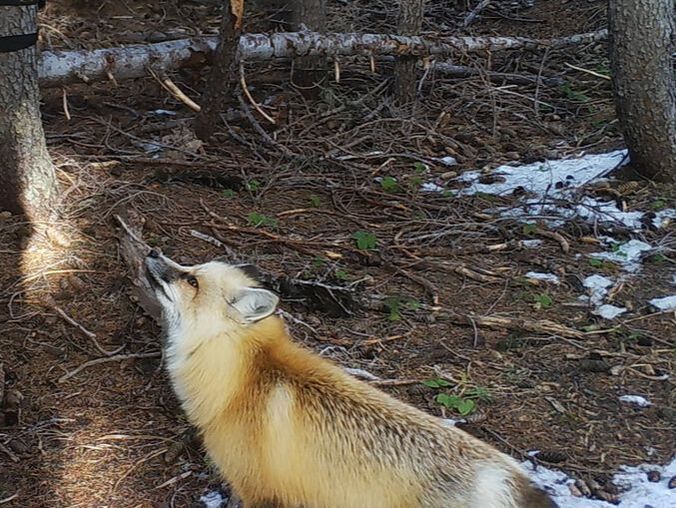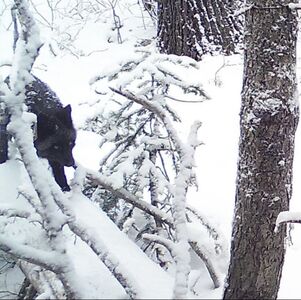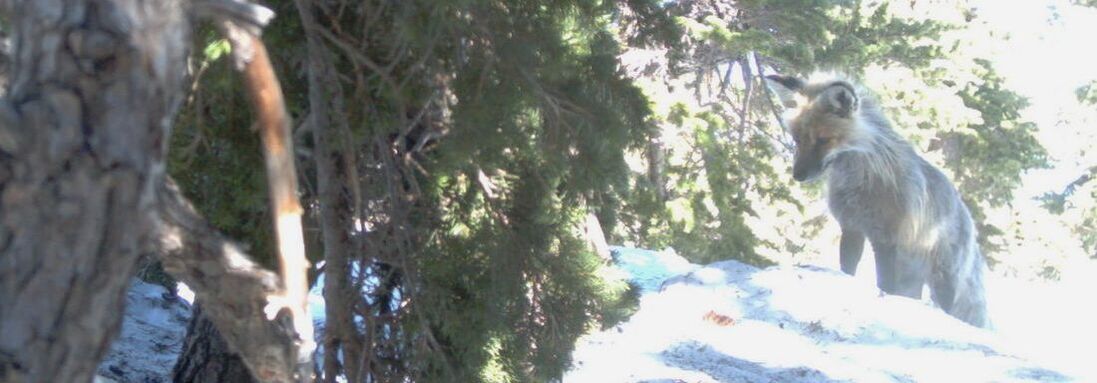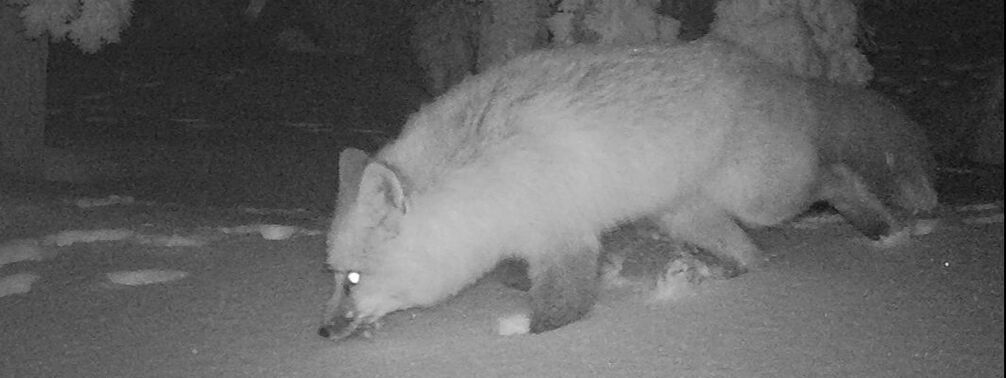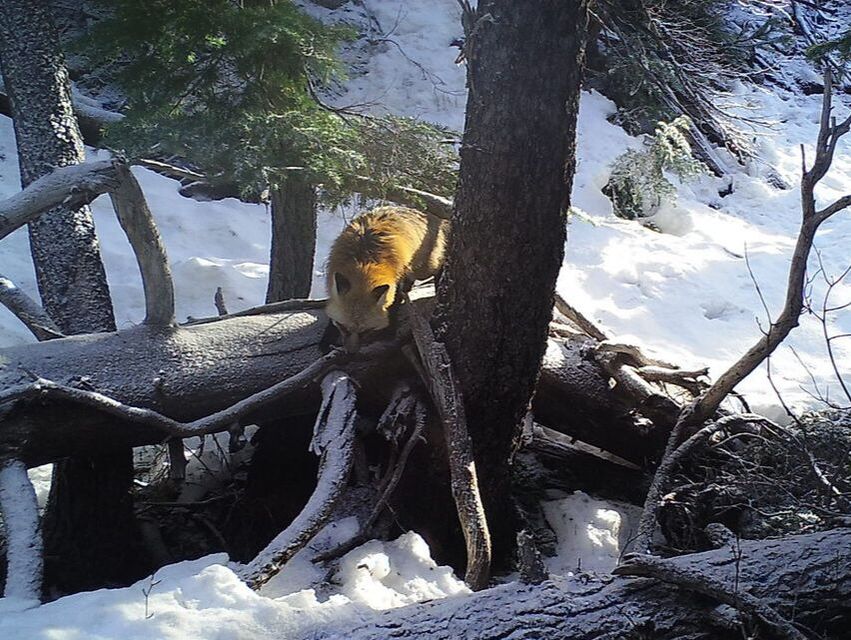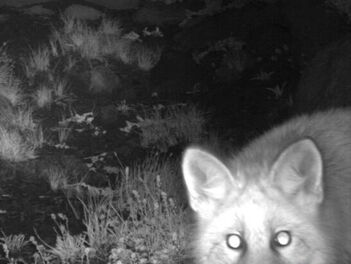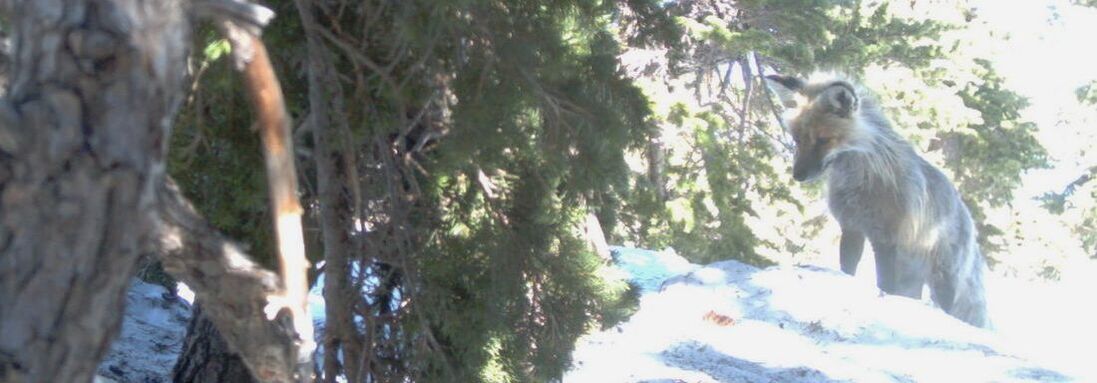WOLVERINE TRACKING PROJECT
sierra nevada red fox scat survey
|
Often, the only way to detect an animal in an area is by the sign they leave behind - scat! This sign not only tells us about an animal's presence, but provides genetic samples that provide an abundance of valuable data.
Scat surveys are an important means of collecting information from otherwise elusive and difficult to study animals, making this survey method especially well-suited for the Wolverine Tracking Project's pursuit of rare carnivores in the Mt Hood National Forest.
Read more about the Wolverine Tracking Project |
get involved
|
Like all our wildlife surveys, data in the Sierra Nevada Red Fox Scat Survey is collected entirely by volunteers. We are looking for hikers, amblers, trekkers, backpackers, and alpine explorers to lend their eyes while they are hiking on mountain trails.
Sierra Nevada red fox, like other canines, use scat to mark their territory, and often leave it on trails or other travel corridors. Choose your favorite trail on Mt Hood, and watch your step! We provide training, supplies, and a list of recommended trails - keep scrolling for more information. |
About sierra nevada red fox
|
The Sierra Nevada red fox (Vulpes vulpes necator) is one of the rarest mammals in North America. A subspecies of red fox, the Sierra Nevada red fox is found only on the mountain slopes of the Cascades south of the Columbia River and the California Sierra Nevadas.
Due to their montane habitat, low population numbers, and elusive nature, there is much we do not know about them. In fact, their presence on Mt Hood was only recently confirmed in 2012 - by the Wolverine Tracking Project! Sierra Nevada red fox are one of the species of greatest concern in Oregon. The data collected will fill important information gaps about their distribution, ancestry, population size, and habitat connectivity. To answer these questions, we need to know not only that these foxes are here, but need their genetic information as well, making scat surveys a perfect survey method. Read more about the Sierra Nevada red fox. |
where and when to go hiking
|
When and where you hike is up to you
Most scat surveys are self-organized, meaning that you get to choose when and where you go. We have recommend trails in Mt Hood National Forest that we have determined as the most likely habitats or where we have the most need for scat surveys (see map on right/below). Recommended survey areas include the Timberline Trail and its offshoots, Surveyor's Ridge area, and Badger Creek Wilderness. Choose a spot that fits your hiking abilities, time commitment, and preferences. Hiking in a different area? Areas not on this map can yield great data as well! The range of the Sierra Nevada red fox may still not be fully documented, so looking in other areas may end up providing valuable new information. After completing the training, we would like to to complete at least 2 scat surveys. However, you are welcome to do as many as you are able, from one to one-hundred. group survey tripsWe will organize two group surveys this summer for those who want to meet other volunteers, go out with a group, or see in-person how the surveys work.
Group survey dates: Saturday, June 22 Saturday, July 13 Location and times TBD. |
equipment needed
|
We can provide materials, including:
If you would like to supply your own materials to avoid having to travel to our office, you are welcome to do so.
trainingBefore heading out to the field, volunteers need to attend an online training session. In this training, you will learn about:
When: Wednesday, June 5, 2024, 6:30-8:00pm Where: Online The training will be recorded for those unable to attend. Guest speakers: Marwa Mahmoud, Washington State University Salix Scoresby, Northern Arizona University |
VOLUNTEER qualifications
Everyone is welcome to join the Fox Scat Surveys. However, you will need the following skills and equipment:
- Able to commit to carrying out at least two surveys during the summer.
- Transportation to and from trailheads
- Able to hike on trails in varying conditions
- Able to follow sample collection instructions and protocols
- Able to drop samples off at our office in NE Portland
- Phone or camera to take photos of scat samples prior to collection
- GPS or mobile device to record location hiked, distance traveled, and the location of any samples - or the ability to relay this information on a map
- Personal gear and personal safety gear - see our packing list for recommendations
All volunteers have the option to receive the Cascadia Wildlife Weekly Newsletter, which includes all the week's best wildlife photos and news - and have access to all of the season's camera photos - exclusive for volunteers and members!
Volunteers also have access to the data collected in one season, and are eligible to receive discounts on select Cascadia Wild classes, events, and programs.
Volunteers also have access to the data collected in one season, and are eligible to receive discounts on select Cascadia Wild classes, events, and programs.
what is the scat used for?
This summer, the scat is being used by two different research projects.
- Marwa Mahoud, graduate student at Washington State University, is studying red fox distribution throughout the Cascades.
- Salix Scoresby, graduate student with Northern Arizona University, is studying red fox diet.
- In addition, the data will be added to long term databases and made available to others who need it. Previous data has directly contributed to management and research publications. Read more about what the data has been used for.
|
A word from our partner: Hi! My name is Marwa Mahmoud, and I am a second-year master’s student in Daniel Thornton’s Mammal Spatial Ecology and Conservation lab at Washington State University (WSU). I am originally from the outskirts of the Seattle area and have spent 7 seasons working in the field throughout the Oregon and Washington Cascades. My master’s project at WSU focuses on identifying the drivers of distribution for the Sierra Nevada red fox (SNRF) in the Oregon Cascades. Last year we had a successful field season monitoring SNRF in the central Oregon region through scat collection and setting game cameras. I plan to continue my field work this summer to the North and South of Crater Lake National Park as well as in Mount Hood National Forest! In the Mount Hood region, we would love your help with collecting SNRF scat, and checking and taking down game cameras! If you love getting out on the trail and looking for wildlife poop, then I am looking forward to working with you this summer! |
ready to join the fox team?
Registration has closed for 2024, please check back again next year!
Are we interested from scat of other animals?
Yes! We are also interested in scat from two of our other target species, wolverines and gray wolves.
Canine scat is possible to identify from visual characteristics (learn more about scat identification at the training!); read more about wolves and collecting their scat. Wolverine scat, on the other hand, is not very distinctive. If you collect wolverine scat, it must also be accompanied by other sign to demonstrate it is from a wolverine.
Canine scat is possible to identify from visual characteristics (learn more about scat identification at the training!); read more about wolves and collecting their scat. Wolverine scat, on the other hand, is not very distinctive. If you collect wolverine scat, it must also be accompanied by other sign to demonstrate it is from a wolverine.
Interested but have questions? Contact us and we'll be happy to talk with you!
REGISTRATION HAS ENDED FOR SUMMER 2023
PLEASE CHECK BACK NEXT year!
text from 2023
The genetic samples (scat) collected on the Fox Survey provides invaluable data that tell us about the diversity, ancestry, population, habitat connectivity, and more about the Sierra Nevada red fox. In turn, this information helps wildlife researchers and managers understand their needs and better protect this rare fox.
The genetic data from the scat survey will be used by researchers to determine the
The Sierra Nevada red fox is designated as a sensitive species and classified as a data gap species in Oregon. In 2016, the Sierra Nevada red fox was considered for protection as a threatened or endangered subspecies under the Endangered Species Act, but was denied due to lack of information. One of the areas lacking in information is population, its size and whether the full extent of their population is documented. There is also the question of their continued uniqueness as a subspecies in the face of potential interbreeding with other fox subspecies, such as the red foxes adapted to lower elevations, who are a mix of native ancestry and populations brought over from the eastern United States and from Europe. This survey hopes to bridge some of these gaps in our knowledge about the Sierra Nevada red fox.
Sierra Nevada red fox genetic samples are analyzed by Oregon Department of Fish and Wildlife. Data about Sierra Nevada red fox is shared with a variety of partners, including: Cascades Carnivore Project, Mt Hood National Forest Service, and Defenders of Wildlife.
The genetic samples (scat) collected on the Fox Survey provides invaluable data that tell us about the diversity, ancestry, population, habitat connectivity, and more about the Sierra Nevada red fox. In turn, this information helps wildlife researchers and managers understand their needs and better protect this rare fox.
The genetic data from the scat survey will be used by researchers to determine the
- native ancestry,
- population size,
- distribution, and
- connectivity of these montane red fox populations.
The Sierra Nevada red fox is designated as a sensitive species and classified as a data gap species in Oregon. In 2016, the Sierra Nevada red fox was considered for protection as a threatened or endangered subspecies under the Endangered Species Act, but was denied due to lack of information. One of the areas lacking in information is population, its size and whether the full extent of their population is documented. There is also the question of their continued uniqueness as a subspecies in the face of potential interbreeding with other fox subspecies, such as the red foxes adapted to lower elevations, who are a mix of native ancestry and populations brought over from the eastern United States and from Europe. This survey hopes to bridge some of these gaps in our knowledge about the Sierra Nevada red fox.
Sierra Nevada red fox genetic samples are analyzed by Oregon Department of Fish and Wildlife. Data about Sierra Nevada red fox is shared with a variety of partners, including: Cascades Carnivore Project, Mt Hood National Forest Service, and Defenders of Wildlife.

